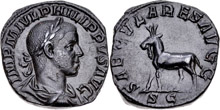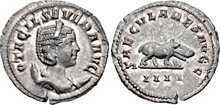Ancient Coins: The Saecular Games on Imperial Roman Coinage
Posted on 3/13/2012
The Saecular Games represented an important religious holiday to the ancient Romans; a rare, three-day festival of theatrics and ritualistic sacrifice originally designed to occur once every hundred and ten years, though this was not always the case in practice. This period of time, a saeculum, was thought to be the longest possible human lifespan, with the idea being that no one could view two sets of Games in a lifetime. The Saecular Games marked both the end of one of these periods and the beginning of yet another.
 Although the Saecular Games stretch back to the quasi-historical period of the early Roman Republic, they were held only sporadically for centuries until revived by the first Roman Emperor, Augustus (27 BC – AD 14), in 17 BC. The festivities were commemorated by the emperor on this rare silver denarius, struck during the year of the Games. On the obverse appears what is perhaps a portrait of the deified Julius Caesar, while the reverse features a herald of the Games, holding a caduceus and ornamented shield. The inscription, “AVGVST • DIVI • F • LVDOS • SAE,” directly references the Games.
Although the Saecular Games stretch back to the quasi-historical period of the early Roman Republic, they were held only sporadically for centuries until revived by the first Roman Emperor, Augustus (27 BC – AD 14), in 17 BC. The festivities were commemorated by the emperor on this rare silver denarius, struck during the year of the Games. On the obverse appears what is perhaps a portrait of the deified Julius Caesar, while the reverse features a herald of the Games, holding a caduceus and ornamented shield. The inscription, “AVGVST • DIVI • F • LVDOS • SAE,” directly references the Games.
 Likewise, this denarius was struck the same year and also commemorates the event with a portrait of Augustus on the obverse and an apex flaminis (ceremonial cap) between two ancilia (shields) on the reverse.
Likewise, this denarius was struck the same year and also commemorates the event with a portrait of Augustus on the obverse and an apex flaminis (ceremonial cap) between two ancilia (shields) on the reverse.
The Saecular Games were next held under Claudius (AD 41-54), c. AD 47/8, as a celebration of the 800th anniversary of the founding of Rome (a date fixed at April 21, 753 BC in the Roman calendar) rather than in observance of the traditional hundred and ten year cycle.
 Following this, the Games also occurred during the reign of Domitian (AD 81-96), in AD 88, technically only one hundred and five years after the Games of Augustus, and just forty years after the Games of Claudius, illustrating the chronological inconsistency of the festival. This bronze dupondius is an attractive example of the type struck in AD 88 to commemorate Domitian’s Games. The obverse features the emperor, while the reverse depicts Domitian sacrificing while the river-god Tiber reclines to the left, with a temple and flute players in the background.
Following this, the Games also occurred during the reign of Domitian (AD 81-96), in AD 88, technically only one hundred and five years after the Games of Augustus, and just forty years after the Games of Claudius, illustrating the chronological inconsistency of the festival. This bronze dupondius is an attractive example of the type struck in AD 88 to commemorate Domitian’s Games. The obverse features the emperor, while the reverse depicts Domitian sacrificing while the river-god Tiber reclines to the left, with a temple and flute players in the background.
 In addition to several bronze issues, silver denarii and gold aurei commemorating the Games under Domitian were also struck. This denarius, which was struck in late AD 88, features a portrait of the emperor on the obverse, and a cippus and Games-related inscription within a wreath on the reverse.
In addition to several bronze issues, silver denarii and gold aurei commemorating the Games under Domitian were also struck. This denarius, which was struck in late AD 88, features a portrait of the emperor on the obverse, and a cippus and Games-related inscription within a wreath on the reverse.
 Antoninus Pius (AD 138-161) hosted the next Saecular Games in AD 148, following the century-cycle of Claudius and commemorating the 900th anniversary of Rome. Though they may not have been referred to as the “Saecular Games” during this event, Pius did strike coins during the AD 140s in anticipation of the 900th anniversary and (presumably) the ensuing celebration. This denarius, minted in AD 140, depicts Pius on the obverse and the she-wolf with the suckling twins Remus and Romulus on the reverse, a representation of the foundation myth of Rome.
Antoninus Pius (AD 138-161) hosted the next Saecular Games in AD 148, following the century-cycle of Claudius and commemorating the 900th anniversary of Rome. Though they may not have been referred to as the “Saecular Games” during this event, Pius did strike coins during the AD 140s in anticipation of the 900th anniversary and (presumably) the ensuing celebration. This denarius, minted in AD 140, depicts Pius on the obverse and the she-wolf with the suckling twins Remus and Romulus on the reverse, a representation of the foundation myth of Rome.
 The next Games were held in AD 204, during the reign of Septimius Severus (AD 193-211), which restored the hundred and ten year cycle established by Augustus in 17 BC. This denarius was struck the year of the Games. It features an inscription possibly unique amongst denarii of Severus, and displays a bust of the emperor on the obverse and his sons Caracalla (as Hercules) and Geta (as Bacchus) on the reverse. The latter stands to the left, with panther at feet, while the former, holding a club, stands right.
The next Games were held in AD 204, during the reign of Septimius Severus (AD 193-211), which restored the hundred and ten year cycle established by Augustus in 17 BC. This denarius was struck the year of the Games. It features an inscription possibly unique amongst denarii of Severus, and displays a bust of the emperor on the obverse and his sons Caracalla (as Hercules) and Geta (as Bacchus) on the reverse. The latter stands to the left, with panther at feet, while the former, holding a club, stands right.
 This extremely rare gold aureus was struck in the same year and features an expressive portrait of fine style on the obverse, while the reverse scene is duplicated from the denarius discussed above.
This extremely rare gold aureus was struck in the same year and features an expressive portrait of fine style on the obverse, while the reverse scene is duplicated from the denarius discussed above.
Some of the most interesting coinage associated with the Games was produced to commemorate the Saecular Games held during the reign of Philip I (AD 244-249) in AD 248. According to ancient accounts, the festivities were spectacular and included the slaying of perhaps as many as 1,000 gladiators and hundreds of exotic animals, even including hippopotami and one rhinoceros. Additionally, it was during this holiday that Philip I elevated his son, Philip II (AD 247-249), to the rank of co-Augustus.
Commemorative bronze and silver issues for both Philips feature a series of exotic animals on the reverse, no doubt linked to the exhibition and slaying of the beasts at the Games. This bronze sestertius of Philip I on the left displays his portrait on the obverse and a lion on the reverse. Another interesting sestertii type employs an elephant, represented here by this fine example. 

Following the theme established by his father’s commemorative coinage, the sestertius below of Philip II displays his portrait paired with a European elk on the reverse. In addition, issues of Otacilia Severa (wife of Philip I, mother of Philip II) were struck in bronze, silver and gold to commemorate the Games. This piece, a silver double-denarius struck in AD 248, exhibits her portrait on the obverse along with a wonderfully exaggerated hippopotamus on the reverse.


Though later Roman emperors such as Gallienus (AD 253-268) and Maximian (AD 286-305) held Games in c. AD 260 and AD 294, respectively, the pagan-influenced festival had fallen into disfavor by the fourth century AD as Christianity became increasingly influential. The last Games were held in AD 404, by special decree of Honorius (AD 405-423) to appease pagan factions after an important military victory.
Bronze, silver, and gold issues of the Saecular Games represent an extremely interesting subset of Roman Imperial coinage. Unusual and beautiful reverse designs commemorate an event that was celebrated by many generations of Romans. Though some coins are rare and command substantial premiums, the collector on a budget can assemble several bronze and silver examples of Saecular Games commemorative coinage for a surprisingly reasonable cost.
Images courtesy of Classical Numismatic Group.
Stay Informed
Want news like this delivered to your inbox once a month? Subscribe to the free NGC eNewsletter today!
